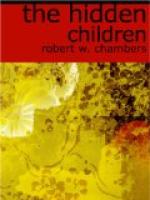Now that the sun had risen I worried not at all over our future prospects, believing that we would hear from our advancing army by afternoon; and the Sagamore was of my opinion.
And even while we were discussing these chances, leaning against our log abattis in the sunshine, far away across the sunlit flat-woods we saw a man come out among the ferns from the southward, and lie down. And then another man came creeping from the south, and another, and yet another, the sunlight running red along their rifle barrels.
After them went both Oneidas, gliding swiftly out and speeding forward just within the encircling cover, taking every precaution, although we were almost certain that the distant scouts were ours.
And they proved to be my own men— a handful of Morgan’s— pushing far in advance to reconnoitre Catharines-town from the south, although our main army was marching by the western ridges, where Boyd had marked a path for them.
A corporal in my corps, named Baily, came back with the Oneidas, climbed with them over the logs, sprang down inside, and saluted me coolly enough.
His scout of four, he admitted, had made a bad job of the swamp trail— and his muddy and disordered dress corroborated this. But the news he brought was interesting.
He had not seen Boyd. The Battle of the Chemung had ended in a disorderly rout of Butler’s army, partly because we had outflanked their works, partly because Butler’s Indians could not be held to face our artillery fire, though Brant displayed great bravery in rallying them. We had lost few men and fewer officers; grain-fields, hay-stacks, and Indian towns were afire everywhere along our line of march.
Detachments followed every water-course, to wipe out the lesser towns, gardens, orchards, and harvest fields on either flank, and gather up the last stray head of the enemy’s cattle. The whole Iroquois Empire was now kindling into flames and the track our army left behind it was a blackened desolation, as horrible to those who wrought it as to the wretched and homeless fugitives who had once inhabited it.
He added to me in a lower voice, glancing at my Indians with the ineradicable distrust of the average woodsman, that our advanced guard had discovered white captives in several of the Indian towns— in one a young mother with a child at her breast. She, her husband, and five children had been taken at Wyoming. The Indians and Tories had murdered all save her and her baby. Her name was Mrs. Lester.
In one town, he said, they found a pretty little white child, terribly emaciated, sitting on the grass and playing with a chicken. It could speak only the Iroquois language. Doubtless its mother had been murdered long since. So starved was the little thing that had our officers not restrained it the child might have killed itself by too much eating.
Also, they found a white prisoner— a man taken at Wyoming, one Luke Sweatland; and it was said in the army that another young white girl had been found in company with her little brother, both painted like Indians, and that still another white child was discovered, which Captain Machin had instantly adopted for his own.




